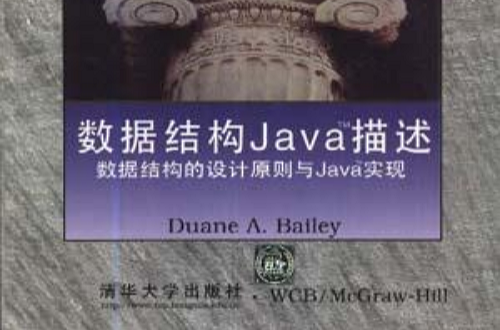《數據結構Java描述--數據結構的設計原則與Java實現》是1999年清華大學出版社出版的圖書,作者是DuaneA.Bailey。
基本介紹
- 作者:Duane A.Bailey
- ISBN:9787302021926
- 頁數:369
- 定價:32.00
- 出版社:清華大學出版社
- 出版時間:1999-12
- 裝幀:平裝
內容介紹
作品目錄
Preface
0 Introduction
0.1 Read Me
0.2 He Can't Say That, Can He?
1 The Object-Oriented Method
1.1 Data Abstraction and Encapsulation
1.2 The Object Model
1.3 Object-Oriented Terminology
1.4 Sketching an Example: A Word List
1.5 A Special Purpose Class: A Bank Account
1.6 A General Purpose Class: An Association
1.7 Interfaces
1.8 Who Is the User?
1.9 Conclusions
2 Comments, Conditions, and Assertions
2.1 Pre- and Postconditions
2.2 Assertions
2.3 Craftsmanship
2.4 Conclusions
3 Vectors
3.1 Application: The Word List Revisited
3.2 Application: Word Frequency
3.3 The Interface
3.4 The Implementation
3.5 Extensibility: A Feature
3.6 Application: The Matrix Class
3.7 Conclusions
4 Design Fundamentals
4.1 Asymptotic Analysis Tools
4.1.1 Time and Space Complexity
4.1.2 Examples
4.1.3 The Trading of Time and Space
4.2 Self-Reference
4.2.1 Recursion
4.2.2 Mathematical Induction
4.3 Properties of Design
4.3.1 Symmetry
4.3.2 Friction
4.4 Conclusionp
5 Sorting
5.1 Approaching the Problem
5.2 Selection Sort
5.3 Insertion Sort
5.4 Mergesort
5.5 Quicksort
5.6 Sorting Objects
5.7 Vector-Based Sorting
5.8 Conclusions
6 Lists
6.1 Example: A Unique Program
6.2 Example: Free-Lists
6.3 Implementation: Singly-Linked Lists
6.4 Implementation: Doubly-Linked Lists
6.5 Implementation: Circularly-Linked Lists
6.6 Conclusions
7 Linear Structures
7.1 Stacks
7.1.1 Example: Simulating Recursion
7.1.2 Vector-Based Stacks
7.1.3 List-Based Stacks
7.1.4 Comparisons
7.2 Queues
7.2.1 Example: Solving a Coin Puzzle
7.2.2 List-Based Queues
7.2.3 Vector-Based Queues
7.2.4 Array-Based Queues
7.3 Example: Solving Mazes
7.4 Conclusions
8 Iterators
8.1 Java's Enumeration Interface
8.2 The Iterator Interface
8.3 Example: Vector Iterators
8.4 Example: List Iterators
8.5 Example: Filtering Iterators
8.6 Conclusions
9 Ordered Structures
9.1 Comparable Objects
9.1.1 Example: Comparable Integers
9.1.2 Example: Comparable Associations
9.2 Keeping Structures Ordered
9.2.1 The OrderedStructure Intertace
9.2.2 The Ordered Vector
9.2.3 Example: Sorting
9.2.4 The Ordered List
9.2.5 Example: The Modified Parking Lot
9.3 Conclusions
10 Trees
10.1 Terminology
10.2 The Interface
10.3 Motivating Example: Expression Trees
10.4 Implementation
10.4.1 The BinaryTreeNode Implementation
10.4.2 Implementation of the BinaryTree Wrapper
10.5 Traversals
10.5.1 Preorder Traversal
10.5.2 Inorder Traversal
10.5.3 Postorder Traversal
10.5.4 Levelorder Traversal
10.5.5 Recursion in Iterators
10.6 Property-Based Methods
10.7 Example: Huffman Compression
10.8 Conclusions
11 Priority Queues
11.1 The Interface
11.2 Example: Improving the Huffman Code
11.3 Priority Vectors
11.4 A Heap Implementation
11.4.1 Vector-Based Heaps
11.4.2 Example: Heapsort
11.4.3 Skew Heaps
11.5 Example: Circuit Simulation
11.6 Conclusions
12 Search Trees
12.1 Binary Search Trees
12.2 Example: Tree Sort
12.3 Implementation
12.4 Splay Trees
12.5 Splay Tree Implementation
12.6 Conclusions
13 Dictionaries
13.1 The Interface
13.2 Unit Cost Dictionaries: Hash Tables
13.2.1 Open Addressing
13.2.2 External Chaining
13.2.3 Generation of Hash Codes
13.2.4 Analysis
13.3 Ordered Dictionaries and Tables
13.4 Example: Document Indexing
13.5 Conclusions
14 Graphs
14.1 Terminology
14.2 The Graph Interface
14.3 Implementations
14.3.1 Abstract Classes
14.3.2 Adjacency Matrices
14.3.3 Adjacency Lists
14.4 Examples: Common Graph Algorithms
14.4.1 Reachability
14.4.2 Topological Sorting
14.4.3 Transitive Closure
14.4.4 All Pairs Minimum Distance
14.4.5 Greedy Algorithms
14.5 Conclusions
A A Sip of Java
A.l A First Program
A.2 Declarations
A.2.1 Primitive Types
A.2.2 Reference Types
A.3 Important Classes
A.3.l The ReadStream Class
A.3.2 PrintStreams
A.3.3 Strings
A.4 Control Constructs
A.4.l Conditional Statements
A.4.2 Loops
A.5 Methods
A.6 Inheritance and Subtyping
A.6.l Inheritance
A.6.2 Subtyping
A.6.3 Interfaces and Abstract Classes
B Use of the Keyword Protected
C Principles
D Structure Package Hierarchy
E Selected Answers
Index

